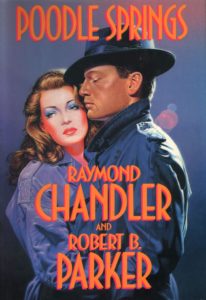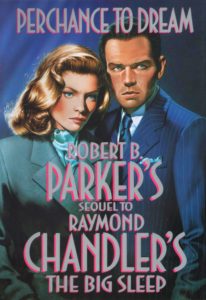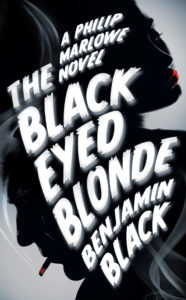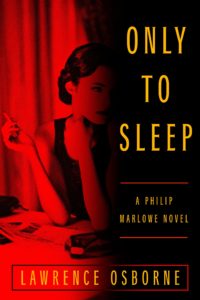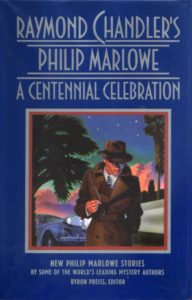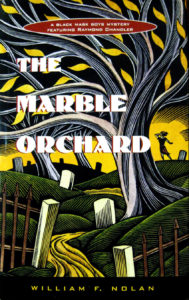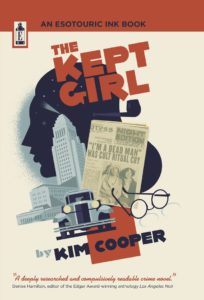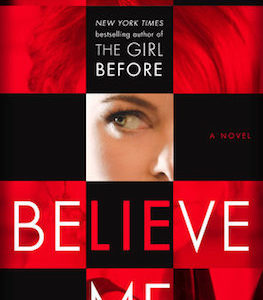He originally went by different monikers, in different pulp-era short stories: Mallory, John Dalmas, Carmady, Ted Malvern. Yet by the time he narrated Raymond Chandler’s debut novel, The Big Sleep (1939), he’d become private eye Philip Marlowe. Cool. Smart. At times compassionate and funny. A former investigator with the Los Angeles District Attorney’s Office (fired for insubordination). Not so much a hard-boiled character as a romantic figure surviving in a hard-boiled world. “He is a lonely man,” Chandler once wrote of the type, “and his pride is that you will treat him as a proud man or be very sorry you ever saw him.”
Marlowe has become such an archetype of the fictional American private investigator, it’s easy to forget that he starred in only seven Chandler novels, from The Big Sleep through the equally renowned Farewell, My Lovely (1940) and The Long Goodbye (1953), to Playback (1958). The author’s demise in 1959, though, didn’t compel his protagonist to hang up his fedora and firearms forever. Over the last three decades, the Chandler estate has selected other wordsmiths to appropriate the detective for use in their own books. This month sees the release of one such Marlowe outing, Only to Sleep, by British-born Bangkok resident Lawrence Osborne. Paired with the recent publication of The Annotated Big Sleep, it reminds us that the streets down which Marlowe tramps may be mean, but they sure have carried him a long way.
Below are eight books by authors other than Chandler, all of which imagine either Marlowe or the author himself hunting for clues and criminals.
Poodle Springs by Raymond Chandler and Robert B. Parker (1989)
When he passed away, Chandler left behind the first four chapters of an eighth Marlowe novel tentatively titled The Poodle Springs Story. It imagined his relatively poor gumshoe freshly wed to Linda Loring, the fetching daughter of a newspaper tycoon he’d met in The Long Goodbye, and who had proposed to him at the end of Playback. Thirty years later, Robert B. Parker, the creator of another hard-boiled peeper, Boston-based Spenser—whose moral code and verbal celerity showed Marlowe’s inspiration—finally completed Poodle Springs. The yarn sends Marlowe to a fictionalized Palm Springs, California (“Poodle Springs, I call it,” Chandler wrote back in 1958, “because every third elegant creature you see has at least one poodle”), where Linda has rented a chi-chi house that “stank decorator.” Bridling at his kept-man role, Marlowe tries to make the most of this resort-town posting, renting a fly-specked office and even scoring a new client: Manny Lipshultz, the operator of an illegal desert gambling club, who wants the detective to locate Les Valentine, a Springs photographer—also with a socialite spouse—who’s skipped out on an IOU to the club for $100,000. Marlowe soon unmasks Valentine as a bigamist, with a surplus household in L.A. and a history of snapping pornographic pictures—which has already led to blackmail and perhaps, lately, homicide. Parker deftly employs his double-identities theme to illuminate both hypocrisies among the rich and Marlowe’s marital discomforts. We’ll never know whether Chandler could have built any better on his opening.
Perchance to Dream by Robert B. Parker (1991)
Unfortunately, Parker’s second poaching of Chandler’s leading man is neither so stylish nor so satisfying as Poodle Springs. Perchance, a sequel to The Big Sleep, returns us several years later to the estate of General Guy Sternwood. The wheelchair-bound oil baron has gone to his grave, and now his nymphomaniac/psychopathic younger daughter, Carmen, has gone astray from Resthaven, the deluxe sanitarium to which she’d been consigned. Since nobody else seems concerned by Carmen’s disappearance, it falls to the Sternwoods’ butler to seek Marlowe’s aid in retrieving her. Resthaven’s arrogant and suspiciously unlicensed director stonewalls the P.I., and Carmen’s elder sister, Vivian Regan, would prefer to pawn the matter off to her boyfriend, “gambler, gunman, all-around crook” Eddie Mars. Marlowe’s probing ultimately suggests Carmen was escorted from Resthaven by a wealthy, politically protected sadomasochist, who may be connected to the discarded, dismembered corpse of a young woman as well as a water rights swindle straight out of the Chandleresque flick Chinatown. Parker emphasizes this book’s link to The Big Sleep by quoting chunks of the original; however, that only leads to unfavorable comparisons between Parker’s prose and that of Chandler at the height of his writing prowess.
The Black-Eyed Blonde by Benjamin Black (2014)
If The Big Sleep deserves a follow-up, then why not The Long Goodbye? Irishman John Banville, under his mystery-writing Black pseudonym, delivers us back to sun-flogged L.A. in the early 1950s, where we witness Marlowe accepting a case from curvaceous young perfume heiress Clare Cavendish. She says her paramour, Nico Peterson, a Hollywood talent agent short on talent and long on caddish impulses, vanished two months ago. She wants him back. Marlowe is skeptical, and with good reason: He learns Nico didn’t simply drop out of sight—he was the victim of a hit-and-run accident outside Pacific Palisades’s ritzy Cahuilla Club. So why, Clare counters, did she recently spot him in San Francisco? And whose corpse had been misidentified as Nico’s? Marlowe spars with cops, crooks, and club managers alike, but seems to be getting nowhere. It looks as if he’ll finally catch a break when he tracks down Nico’s sister; but she’s promptly kidnapped, and subsequently brutalized. Banville captures the bleakness, sardonic dialogue, periodic pummelings, and bent toward clever observations over tight plotting that marked Chandler’s storytelling. Although his witticisms pale beside the master’s (“The house wasn’t all that big, if you consider Buckingham Palace a modest little abode”), Banville does give us Marlowe in all his weary, determinedly hopeful, gumshoe-Galahad glory. Oh, and he provides a coda to The Long Goodbye that may leave some readers cursing the author’s name—one or the other of them.
Only to Sleep by Lawrence Osborne (2018)
Osbourne’s approach to composing a Marlowe novel is particularly interesting, not because he’s produced a pitch-perfect treatment of the protagonist (the sleuth here could’ve gone unnamed and been equally appealing), but because his story is as much a meditation on old age as it is a mystery. The year is 1988, and a 72-year-old Marlowe—retired for a decade, living in Baja California—is ready for “one last fling of the dice,” one more shot of the adrenaline of purpose. So for an insurance company, he agrees to investigate the “accidental” swimming death of Donald Zinn, a debt-ridden con man/developer. He begins by visiting the California border resort Zinn operated with his wife, Dolores Araya, a stunning Mexican of about 30, less than half Zinn’s age. She assures our hero there was nothing fishy about her hubby’s passing—which only heightens Marlowe’s doubts, makes him wonder whether Zinn is in hiding, waiting to collect the insurance payout and then escape with the canny Dolores. What follows is a languid chase after clues and phantoms, Marlowe with his sword-concealing cane and démodé duds roaming Mexico in pursuit of senescent gents who may or may not be Zinn, but who are living and loving in ways he wishes he still could be. Osborne doesn’t try (too hard) to imitate Chandler’s style and similes, but his prose is evocative and some of his lines will knock you for a loop, such as this sparkler: “Count me as one of those who know that life is unbearable not because it’s tragedy but because it’s romance.”
Raymond Chandler’s Philip Marlowe: A Centennial Celebration, edited by Byron Preiss (1988)
A month after he died, Chandler’s only short story to originally feature Philip Marlowe—“The Pencil” (né “Marlowe Takes on the Syndicate”)—was published. It’s a tight little number about the P.I. helping a mobster to duck a hit man. Three decades later, to commemorate the 100th anniversary of Chandler’s birth in Chicago, editor Byron Preiss assembled 23 of the then best-known crime-fictionists, from Jonathan Valin and Sara Paretsky to Loren D. Estleman and Robert Campbell, to resurrect Marlowe in new brief tales. Several entries in this uneven but enjoyable collection reinforce the shamus’ prohibition against taking on divorce work, among them Benjamin M. Schultz’s own yarn titled “The Black-Eyed Blonde.” Others picture Marlowe mixing with Hollywood types, including Max Allan Collins’s “The Perfect Crime,” based on the alleged 1935 suicide of film comedienne-cum-restaurateur Thelma Todd. Stuart M. Kaminsky’s “Bitter Lemons” turns on old guilt, fresh manslaughter, and the search for a lost sister. Robert Crais’s “The Man Who Knew Dick Bong” has Marlowe protecting a small boy from his self-centered mother. In Ed Gorman’s “The Alibi,” the private eye is called to rescue a former cop who has seriously botched a bodyguarding assignment. And Dick Lochte’s excellent “Sad-Eyed Blonde” is all about betrayal and the hunt for a Maltese Falcon-like treasure. “The Pencil,” too, wins a place in this compilation.
Ten Percent of Life by Hiber Conteris (1987)
Uruguayan writer Conteris became interested in Chandler’s work after being imprisoned in the 1970s for his political outspokenness. Musing on Marlowe’s half-illusory California gave Conteris a mental escape from his cell. Eventually, that daydreaming resulted in this novel wherein Marlowe tackles the 1956 suicide of Hollywood literary representative Yensid Andress, a man accused of defrauding his prestigious clientele. But did Andress actually take his own life? The detective’s reporter pal raises questions enough that Marlowe goes digging into Andress’s customer list for malevolent motives. Andress was known to represent screenwriters blacklisted for their rumored communist sympathies; could politics have hastened his demise? Or might somebody such as (yikes!) Chandler—recognized for his loathing of slippery agents—be behind the killing? Conteris’s Marlowe might not gibe with reader expectations (really, he’s driving a red Triumph and living in a penthouse?), and we’re denied neat answers to all of the puzzles this book presents. Nonetheless, Ten Percent of Life contains some delightful exchanges between Chandler and Marlowe, on subjects ranging from the cutthroat nature of Tinseltown to the artistic value of mystery fiction. And how often do you find those?
The Marble Orchard by William F. Nolan (1996)
While Conteris makes Raymond Chandler share fictional limelight with Marlowe, The Marble Orchard accords him center stage. This is the second installment in Nolan’s “Black Mask Boys” trilogy, each whodunit narrated by a different star contributor to that classic crime-fiction magazine, Black Mask—Dashiell Hammett first, in The Black Mask Murders (1994), and concluding with Sharks Never Sleep (1998), led by Erle Stanley Gardner. Orchard, set in 1936, kicks off with the purported ritual suicide of Julian Pascal in a Chinese cemetery. Pascal, a concert pianist and film score composer, was the second husband of Pearl Eugenie “Cissy” Hurlburt, who divorced him in 1920 and married Chandler (18 years her junior) four years later. Convinced that her ex wouldn’t have offed himself, especially in such peculiar fashion, Cissy asks Chandler to find out for sure. It’s a request that will lead the scribbler to Carmilla Blastok, a spurious Hungarian countess famous for her big-screen vampire roles; Elina Knibbs, Blastok’s estranged sister and Pascal’s rumored lover; and Merv Enright, Elina’s abusive lowlife companion. Although Chandler was, in reality, reserved and depression-prone, under Nolan’s pen he becomes a Marlowe stand-in, wheeling about in his prized Duesenberg, bracing suspects, and absorbing punches, with Gardner and a sharp-shooting Hammett in tow. Nolan is overly fond of celebrity cameos (Shirley Temple, Orson Welles, and Charlie Chaplin proclaiming Chandler “a fool”) as well as lengthy asides on L.A. history, but it’s fun to see “the Boys” living out their crime-fighting fantasies.
The Kept Girl by Kim Cooper (2014)
Philip Marlowe’s creator comes off as far less valiant in Kim Cooper’s The Kept Girl. The action here takes place just before the 1929 stock market crash. Chandler—not yet a published fiction writer, but rather an indolent, heavy-drinking, 41-year-old executive with L.A.’s Dabney Oil Syndicate—is asked by the company’s head, Joseph Dabney, to ascertain what’s become of $40,000 his ne’er-do-well nephew Clifford gave to May Otis Blackburn and her seductive, 20-something daughter, Ruth Wieland Rizzio, operators of a wacky local religious cult called the Divine Order of the Royal Arms of the Great Eleven. Being a less-than-practiced investigator, Chandler recruits the help both of Muriel Fischer, his surprisingly resourceful secretary and mistress (yes, he’s cheating on Cissy!), and Thomas H. James, a cop and law-enforcement reformer. Together, they unearth unsavory facts about young Dabney, the godly grifters whose allegedly divine knowledge of life and death he hopes to exploit, and a dead 16-year-old girl who—according to Blackburn’s instructions—has been buried beneath her parents’ house (together with seven puppies) until she can be miraculously revived. Cooper spins her tale primarily from historical facts, as bizarre and unlikely as they may seem.


